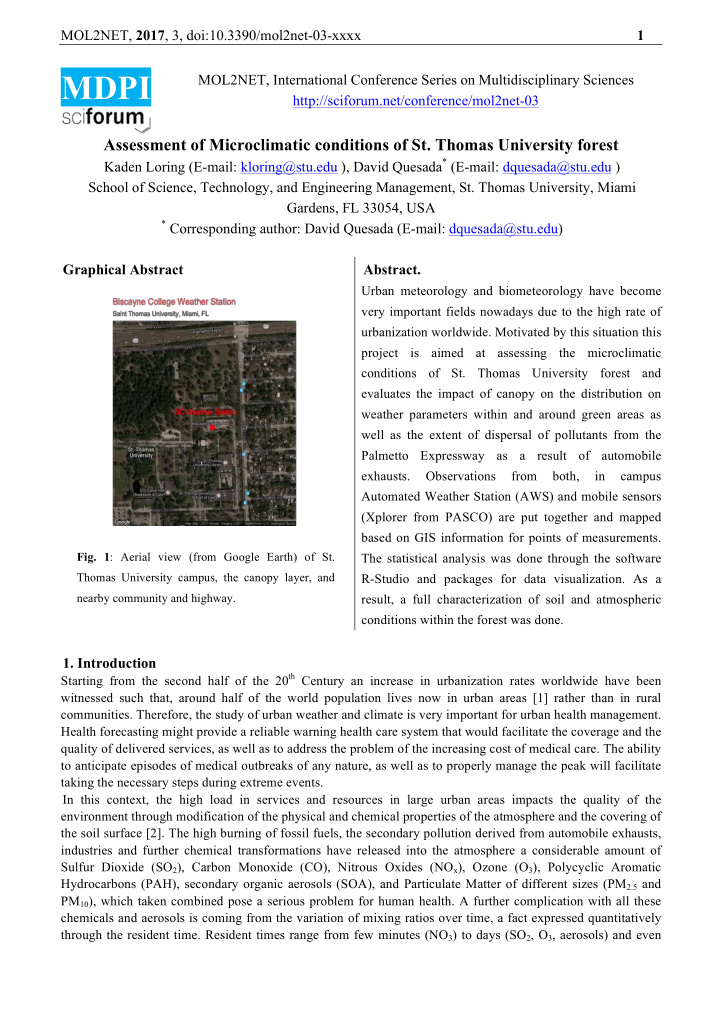



MOL2NET, 2017 , 3, doi:10.3390/mol2net-03-xxxx 1 MDPI MOL2NET, International Conference Series on Multidisciplinary Sciences http://sciforum.net/conference/mol2net-03 Assessment of Microclimatic conditions of St. Thomas University forest Kaden Loring (E-mail: kloring@stu.edu ), David Quesada * (E-mail: dquesada@stu.edu ) School of Science, Technology, and Engineering Management, St. Thomas University, Miami Gardens, FL 33054, USA * Corresponding author: David Quesada (E-mail: dquesada@stu.edu) Graphical Abstract Abstract. Urban meteorology and biometeorology have become very important fields nowadays due to the high rate of urbanization worldwide. Motivated by this situation this project is aimed at assessing the microclimatic conditions of St. Thomas University forest and evaluates the impact of canopy on the distribution on weather parameters within and around green areas as well as the extent of dispersal of pollutants from the Palmetto Expressway as a result of automobile exhausts. Observations from both, in campus Automated Weather Station (AWS) and mobile sensors (Xplorer from PASCO) are put together and mapped based on GIS information for points of measurements. Fig. 1 : Aerial view (from Google Earth) of St. The statistical analysis was done through the software Thomas University campus, the canopy layer, and R-Studio and packages for data visualization. As a nearby community and highway. result, a full characterization of soil and atmospheric conditions within the forest was done. 1. Introduction Starting from the second half of the 20 th Century an increase in urbanization rates worldwide have been witnessed such that, around half of the world population lives now in urban areas [1] rather than in rural communities. Therefore, the study of urban weather and climate is very important for urban health management. Health forecasting might provide a reliable warning health care system that would facilitate the coverage and the quality of delivered services, as well as to address the problem of the increasing cost of medical care. The ability to anticipate episodes of medical outbreaks of any nature, as well as to properly manage the peak will facilitate taking the necessary steps during extreme events. In this context, the high load in services and resources in large urban areas impacts the quality of the environment through modification of the physical and chemical properties of the atmosphere and the covering of the soil surface [2]. The high burning of fossil fuels, the secondary pollution derived from automobile exhausts, industries and further chemical transformations have released into the atmosphere a considerable amount of Sulfur Dioxide (SO 2 ), Carbon Monoxide (CO), Nitrous Oxides (NO x ), Ozone (O 3 ), Polycyclic Aromatic Hydrocarbons (PAH), secondary organic aerosols (SOA), and Particulate Matter of different sizes (PM 2.5 and PM 10 ), which taken combined pose a serious problem for human health. A further complication with all these chemicals and aerosols is coming from the variation of mixing ratios over time, a fact expressed quantitatively through the resident time. Resident times range from few minutes (NO 3 ) to days (SO 2 , O 3 , aerosols) and even
MOL2NET, 2017 , 3, doi:10.3390/mol2net-03-xxxx 2 years (N 2 O) [3]. The extent of the influence also varies spatially; being the micro-scales and meso-scales the most relevant to issues related with urban health effects. St. Thomas forest offers a unique opportunity as a test bed for the above-mentioned effects. It covers a land area where both micro-meteorological and air quality effects might be observed. Its proximity to a highway (Palmetto –SR 826) in Metropolitan Miami allows observing the effect of diesel exhausts spread over nearby communities and the importance of a canopy layer on such dynamics (see Fig. 1). 2 . Data and Methods Observations from both, in campus Automated Weather Station (AWS) running in partnership with Earth-Networks (Weatherbug) and mobile sensors (Xplorer from PASCO) are put together and mapped based on GIS information for points of measurements. The statistical analysis was done through the software RStudio and packages for data visualization. The forest was divided into sections, such that data might be gridded and comparison between different grids was performed (see Fig. 2). In a data set of nearly 28000 observations done from March 1 to June 4, 2017 field campaign, cleaning data properly and efficiently requires Fig. 2 : St. Thomas forest computational functions. To clean the weather station data, a observational grids location. combination of Boolean functions and graphical tests were used. The models were created with the help of R packages ggplot2, EBImage, and ggmap. 3. Results and Discussion The variation of temperature inside the forest is shown in Fig. 3 (a). As can be seen from Fig. 3 (a), temperatures are lower in the densest part of the forest, since the canopy layer blocks sunlight from reaching the ground. Ground level temperature measurements were performed every two hours from 10:00 am to 4:00 pm every day. Additionally, AWS recorded variations of air temperature every hour daily and year round. A comparison of both types of measurement was performed and rapid variations are observed within forest, which are averaged when larger scales are considered. Wind direction and intensity reading from the AWS were mapped into a wind rose (Fig. 3 (b) – polar plot showing the directions from where most likely Fig. 3 : (a) Distribution of ground temperatures within the forest, (b) wind the wind is blowing from). During rose, showing the prevalent winds and their intensity. the period of analysis the wind pattern is most South-South-East (SSE). Therefore, most of the automobile exhausts from Palmetto expressway tend to spread towards the North-North-West (NNW). Fig. 4 : (a) Average soil water content, (b) Average relative humidity within the forest. Another important component to look for is the volumetric water content which is a measure of soil moisture. The GLX device uses capacitance between two metal probes to measure the dielectric permittivity of sampled soil. Due to
Recommend
More recommend